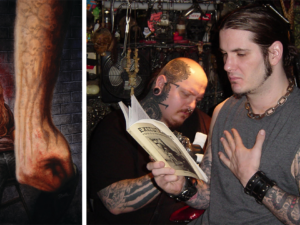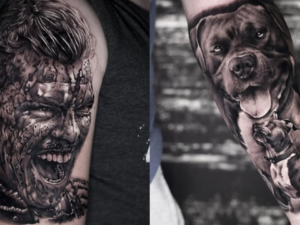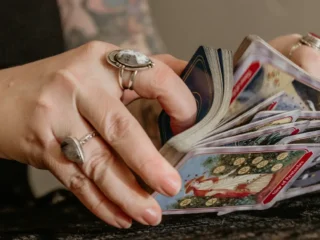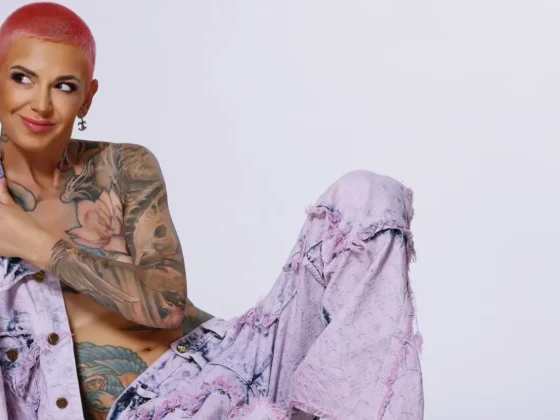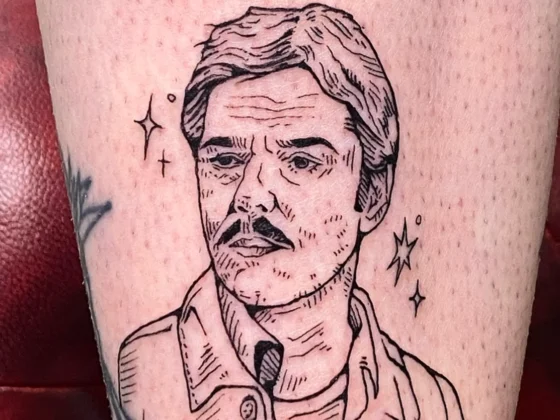Inked Mag
December 27th, 2018
Getting Tattooed With Tourette’s
At 24-years-old, Shanna Ruel was told that when her “brain was changing over into adulthood, something went wrong and this was the result.”
The usual tattoo process is pretty simple. You have your vision, and an artist best suited for it, to transform it into the best piece of art for your body. However, for Shanna Ruel, the tattoo process requires some adjustments.
While Tourette syndrome is most common in children, and often outgrown, Ruel was diagnosed with Tourette’s at 24-years-old.

“When most people think of Tourette’s, they think of someone yelling loud curse words and what not,” Ruel told INKED. “Only 10% of folks with Tourette’s actually curse, but everyone with Tourette’s does have a verbal tic.”
Ruel said she had always had OCD tendencies, but that it never bothered her. “It benefited me in a lot of ways, and still does,” she explained.

At the time of her diagnosis, she was told that when her “brain was changing over into adulthood, something went wrong and this was the result.”
By the time she was diagnosed, she explains she had already made the “typical home tattoo mistakes.”
Before learning to go to a professional artist, she had four tattoos. Her first, being a turtle on her ankle that Ruel drew in high school.
“I was laying on my friends couch, holding the battery pack to the machine, and I watched everyone play Grand Theft Auto while I got tattooed,” she said.
Ruel has nine tattoos now, with most of her left arm covered in individual pieces.

“I knew since I was little that tattoos were of great interest to me, and I always wanted them,” Ruel said. “After I was diagnosed, it didn’t keep me from thinking I could still have dozens of tattoos. I just knew that it would take time and patience to get them, where as most people can make a decision and run with it.”
For Ruel, her process is to plan the tattoo, and “research the studios extensively” as well as “read all the feedback from previous clients.”
Then, she has to wait until she has, what she calls, a “Good Day.”
“You see, with Tourettes, you also get a lovely mix of OCD, Anxiety, and possibly other psychological disorders and syndromes,” she said. “What makes matters worse is that they all feed off of each other. If your anxiety is high, then your tics will likely be really high, which makes your anxiety worse. If you have OCD tendencies, the same things can happen with that too.”

Having a “Good Day,” in being calm, having a positive mood, and feeling overall happiness is important for any tattoo experience. For Ruel, it is essential.
“For the artist, I always make sure they are aware of what I have and what kind of relationship we have to have for the session to go well,” Ruel said. “Patience is essential, and having quick reflexes is just as important. I can hold most physical tics in for a while, but like holding in a sneeze or trying not to scratch an itch, it only makes things worse over time. Eventually you gotta let it out, and often it happens in a much bigger way than it would have been to begin with.”
Ruel says that “When everything aligns” for a “Good Day,” she will have to call the studio to see what their appointment schedule for the day is like. Then, depending on what size tattoo, she can usually show up and wait to be fit in.
“However, larger ones that take a lot of time, I gotta hope for the best.”
Ruel explains that she warns her artists as best she can when she is feeling she is going to twitch or jerk, but that she can’t always tell when they are going to come on.

“When I had the top of my foot tattooed, after 3 hours, my foot would no longer sit still. No matter how hard I tried,” she said. “The artist wasn’t as considerate as he could have been, and it left me with an unfinished piece to this day.”
Ruel’s explains that as her feet are the hardest to control, she is uneasy to try and finish it.

However, Ruel isn’t covered with unfinished work, despite her sessions requiring many breaks and an extreme amount of patience.
She wanted the outside of her forearm tattooed, with coral and a clown fish. After doing her usual extensive research process, she went to an artist named Kahlie Mezzacapa, at Queen City Tattoo Company in Springfield, Missouri.
“It took over 6 hours and several breaks from me, but we got it finished,” Ruel said.

Ruel went back to Queen City Tattoo for her next tattoo, a quote on a lily with watercolor on her inner bicep. While Kahlie was busy, the owner, Donnie Routt, had offered to tattoo Ruel, who was “just as patient and considerate as Kahlie had been.”
While the shop has since closed, and Kahlie and Donnie had moved to new shops, Ruel is hoping to finish a full sleeve on her right arm. She noted that, “hopefully, one day, I’ll be able to get my foot redone and finished.”

Shanna Ruel wishes those with movement disorders and neuropsychiatric disorders knew that their diagnosis does not have to hold them back with things they would like to enjoy. Especially getting a tattoo.
“Though there is a stigma of artists often being full of themselves and having little patience, just do your research and be open with the artist you choose,” Ruel said. “Artists have seen and dealt with all sorts of clients, and most are more than willing to try to accommodate your needs. Just don’t be overly annoying.”
Ruel recommends talking about the limitations ahead of time, as well as what helps keep you calm.

“Personally, I like rocking out to the radio and making small talk over how today’s music isn’t as good as it once was,” she said. “Once, while being tattooed I started having a verbal tic of saying “ba ba ba” and the artist broke into “Barbara Ann” by The Beach Boys. Eventually we both were singing.”
However, Ruel believes the responsibility goes both ways.
For artists, Ruel hopes the tattooing community will learn more about syndromes and disorders like Tourette’s.
“It will benefit you greatly. Not only in understanding what others go through, but also in understanding potential clientele,” Ruel said. “Nowadays, reviews spread like wildfire, and going the extra mile for a client goes a long way towards your credibility as an artist. No one wants to go to a jerk.”

Ruel said OCD, and even Tourette’s, have become her superpower, in that she has harnessed them in a way to benefit her everyday life.
“Bad days for me… well, I sound like Rainman,” Ruel teased. “I talk to myself a lot and yell and curse really loudly. I can’t go into public because most of the time I can’t even walk.”
Ruel explained that her “legs do not cooperate” and her “hands are mostly up by my jerking head, fingers moving all around like I’m hatching an evil plot.”
However, this is where, she says, the OCD comes in handy.
“I’ve learned to give myself a detailed task,” Ruel said. “It could be something like measuring a room and all the furniture. Then drawing out, to scale, the best and most effective way to rearrange the room. This can take several attempts, and many many hours of drawing, but, it has me focused. Usually, by the time I figure something like that out, I have calmed down.”

Inversely, a “Good Day” comes at Ruel by a happy surprise.
“It’s like the world is just working for me,” she said. “I wake up in a phenomenal mood, everything is working for me… or if not, it’s not bothering me.”
Ruel said that these “Good Days” “happen more often than you might think.”
“OCD, and even Tourette’s, can be a blessing in disguise,” she said. “It’s all in how you choose to look at it. It’s the attitude you choose to have facing those times that matters.”
Editor's Picks
Paul Booth Illustrates Cover for Pantera Graphic Novel
The revered tattoo artist created a cover for a graphic novel celebrating the 30th anniversary of “Vulgar Display of Power”
Scary Spider Tattoos
Spiders are terrifying, yet for some reason people sure do love to get tattoos of them


